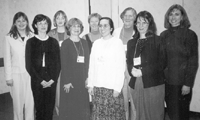AWM---A Vivid Presence at the Joint Mathematics Meetings
April 16, 2000

Margaret Wright of Bell Laboratories, Lucent Technologies, this year's Emmy Noether Lecturer, with Jean Taylor of Rutgers University, president of the Association for Women in Mathematics.
Despite the gratifying quote and reference, anyone in the audience who had heard Wright's invited talk at ICIAM 99 ("What, if Anything, Is New in Optimization?") might have felt a slight twinge of disappointment---in Edinburgh, her talk had been punctuated with quotes from Marcel Proust.
But Wright did not disappoint the audience in Washington, or the Association for Women in Mathematics, which sponsors the annual Noether Lecture, "to honor women who have made fundamental and sustained contributions to the mathematical sciences." For her Noether Lecture---titled "The Mathematics of Optimization"---Wright had found almost uncannily apt quotes from an author whose words needed no tailoring to fit a mathematical setting: Jane Austen.
"He had something to direct his search."From Jane Austen's Pride and Prejudice (chapter 52), the quote was a natural introduction to Wright's discussion of direct search methods---the popular Nelder-Mead method, which for 30 years, despite the absence of theory, surprisingly often "just works," and pattern search methods. (Two speakers at the special session held in Washington in conjunction with the Noether Lecture would be discussing direct search methods, she pointed out; see the photo caption for details about that session.)

To reflect the themes of the Emmy Noether Lecture, Dianne O'Leary of the University of Maryland and Margaret Wright co-organized a special session, sponsored by AMS, AWM, and SIAM, on linear algebra and optimization, two fields with a longstanding connection. Both are fundamental elements of applied mathematics and scientific computing, and their research is often closely related: Optimization methods rely on linear algebra to prove results and solve subproblems, and linear algebra techniques are inspired by needs in optimization.
The nine speakers in the special session, ranging from recent PhDs to more established researchers, are shown above (from left to right) with Margaret Wright (fourth from left): Tamara Kolda, Sandia National Laboratories; Ilse Ipsen, North Carolina State University; Virginia Torczon, College of William & Mary; Jane Cullum, Los Alamos National Laboratory; Niloufer Mackey, Western Michigan University; Anne Greenbaum, University of Washington; Dianne O'Leary; Misha Kilmer, Tufts University; not pictured is Yuying Li, Cornell University. (Haesun Park of the University of Minnesota was unfortunately stricken by flu and could not be present.) Their talks covered a variety of topics: mainstream optimization methods (local convergence of pattern search methods, an asynchronous direct search method); algorithms that blend linear algebra and optimization, with special relevance in image processing (computing confidence intervals, iterative regularization); option pricing via optimization; hierarchical modeling techniques for approximating large systems by small systems; analysis of why the bi-conjugate gradient method is successful; the effects of non-normality on solving linear systems; and new quaternion-based equivalences and algorithms for structured eigenproblems.
Turning to the interior point revolution, Wright pointed out that generalizations of the barrier methods of the 1960s (on which she and others have worked) are back in favor today in the form of primal-dual methods. Certain matrices that arise in interior methods are inherently ill-conditioned, she explained, but the computed results have almost always been unexpectedly accurate. A mathematical explanation was found recently, and here again Jane Austen delivered an insightful comment:
"'Do not give way to useless alarm,' added he, 'though it is right to be prepared for the worst, there is no occasion to look on it as certain' " (Pride and Prejudice, chapter 47). Jane Austen also had the final word in the lecture, about progress in optimization and mathematics:"There will be little rubs and disappointments everywhere, and we are all apt to expect too much; but then, if one scheme of happiness fails, human nature turns to another; if the first calculation is wrong, we make a second better" (Mansfield Park, chapter 5).

